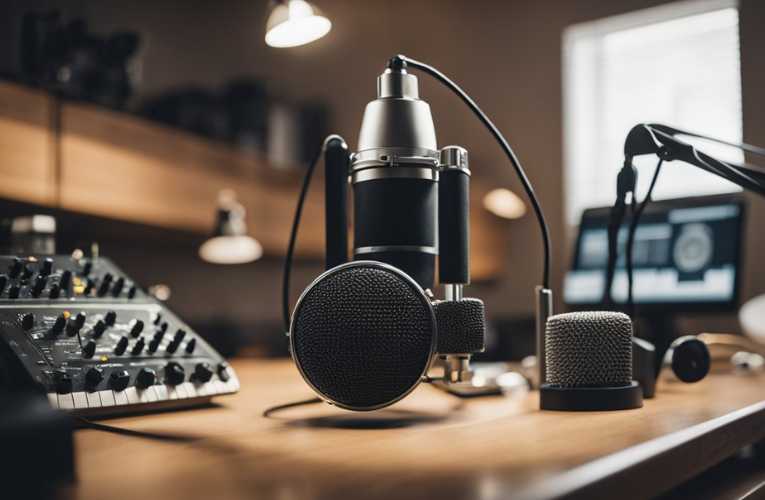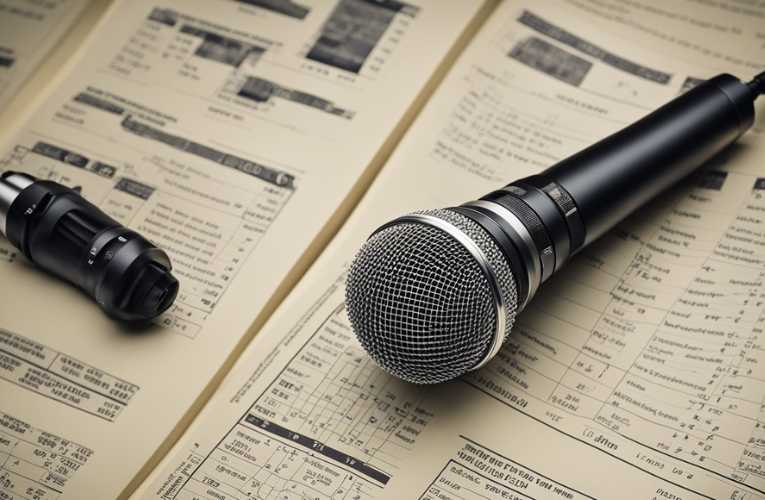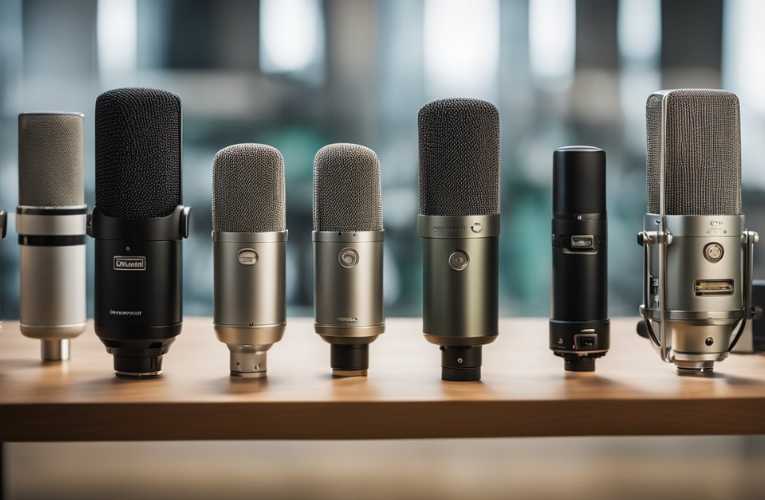If you’re in the market for a tube condenser microphone, you know that there are a lot of options out there. Choosing the right one can be overwhelming, especially if you’re not familiar with the technology. In this article, we’ll guide you how to chose right tube condenser microphone for your needs.
Before we get started, let’s make sure we’re all on the same page. A tube condenser microphone is a type of microphone that uses a vacuum tube to amplify the audio signal. This gives the microphone a warm, rich sound that many people find appealing. Tube condenser microphones are often used for recording vocals, acoustic guitars, and other instruments where a natural, warm sound is desirable.
Key Takeaways
- Understanding the technology behind tube condenser microphones is essential to choosing the right one.
- Assessing your needs, including what you’ll be recording and your budget, is crucial to making the right choice.
- Comparing brands and models and making the final decision can take time, but it’s worth it to get the perfect microphone for your needs.
Table of Contents
ToggleUnderstanding Tube Condenser Microphone

If you are looking for a high-quality microphone that can capture rich and warm audio, a tube condenser microphone might be the right choice for you. These microphones have been around for many decades and are still popular among many audio professionals today. In this section, we will discuss the history and evolution of tube condenser microphones and their basic working principle.
History and Evolution
The first tube condenser microphone was invented in the 1920s and quickly gained popularity among radio broadcasters and recording studios. These early microphones were large and bulky, and they required a lot of power to operate. However, they were able to capture audio with a warm, natural sound that was difficult to achieve with other microphones of the time.
Over the years, tube condenser microphones have evolved and improved in many ways. Today’s tube condenser microphones are much smaller and more efficient than their early predecessors. They are also more reliable and easier to use, making them a popular choice for a wide range of recording applications.
Basic Working Principle
A tube condenser microphone works by converting sound into an electrical signal using an electrostatic condenser capsule. This signal is then sent to a vacuum tube, which amplifies the signal and adds warmth and character to the audio. The amplified signal is then sent to an output transformer, which matches the impedance of the microphone to the input of the recording device.
One of the key advantages of a tube condenser microphone is its ability to capture audio with a warm and natural sound. This is due to the way that the vacuum tube amplifies the audio signal, which adds a subtle harmonic distortion that can be pleasing to the ear. Additionally, tube condenser microphones are highly sensitive and can capture audio with a high degree of detail and nuance.
Related Posts:
Assessing Your Needs

When choosing a tube condenser microphone, it’s essential to assess your needs before making a purchase. This includes considering the intended application, recording environment, and sound characteristics you require.
Intended Application
Consider what you will be using the microphone for. Will you be recording vocals, instruments, or both? Will you be using it for live streaming or studio recording? Different microphones are designed for different purposes, so it’s important to choose one that suits your intended application.
Recording Environment
The recording environment can also impact the microphone’s performance. Consider the acoustics of the room and any ambient noise that may be present. If you’re recording in a noisy environment, a microphone with a directional pickup pattern may be a better choice. If you’re recording in a room with poor acoustics, a microphone with a warm sound characteristic may help compensate for the lack of natural reverb.
Sound Characteristics
Each tube condenser microphone has its own unique sound characteristic. Some microphones have a bright and airy sound, while others have a warm and rich sound. Consider what type of sound you’re looking to achieve and choose a microphone that complements it.
Related Posts:
- Getting the best sound with tube condenser mic for live streaming
- Tube condenser microphone cleaning methods
How to Choose the Right Tube Condenser Microphone

When it comes to choosing the right tube condenser microphone, there are a few key factors to consider. In this section, we’ll cover the most important things to keep in mind when selecting a tube condenser microphone that will best suit your needs.
Sensitivity and SPL Handling
One of the most important factors to consider when choosing a tube condenser microphone is its sensitivity and SPL handling. Sensitivity refers to how well the microphone can pick up sound, while SPL handling refers to how well it can handle loud sounds without distorting or clipping.
When it comes to sensitivity, you’ll want to choose a microphone that is sensitive enough to pick up all the nuances of your sound source, whether it’s vocals, acoustic guitar, or drums. However, you’ll also want to make sure that the microphone has good SPL handling, so that it can handle loud sounds without distorting or clipping.
Self-Noise Level
Another important factor to consider when choosing a tube condenser microphone is its self-noise level. Self-noise is the noise that the microphone generates itself, and it can be a problem if you’re recording quiet sound sources or if you’re using the microphone in a quiet recording environment.
Ideally, you’ll want to choose a microphone with a low self-noise level, so that you can record even the quietest sound sources without any unwanted noise.
Impedance and Output
Finally, you’ll want to consider the impedance and output of the microphone. Impedance refers to the amount of resistance that the microphone presents to the input of your preamp or mixer, while output refers to the level of the microphone’s signal.
In general, you’ll want to choose a microphone with a low output impedance, as this will ensure that the microphone’s signal is not degraded as it travels through your cables and preamps. You’ll also want to choose a microphone with a high output level, so that you can capture a strong, clear signal that is easy to work with in post-production.
By keeping these factors in mind, you’ll be well on your way to choosing the right tube condenser microphone for your needs.
Related Posts:
- Dive into the world of tube condenser microphone specialties
- Choosing Between Tube Condenser and Solid-State Microphones
Comparing Brands and Models
When it comes to choosing the right tube condenser microphone, you will find that there are many brands and models available on the market. It can be overwhelming to decide which one to choose, but there are a few factors to consider that can help you make the right decision. In this section, we will discuss the reputation and reliability, budget and value, and warranty and support of different brands and models of tube condenser microphones.
Reputation and Reliability
When choosing a tube condenser microphone, it is important to consider the reputation and reliability of the brand and model. Some brands have a reputation for producing high-quality microphones that are reliable and durable, while others may have a less favorable reputation. It is important to do your research and read reviews from other users to get an idea of the quality and reliability of a particular brand and model.
Budget and Value
Tube condenser microphones can range in price from a few hundred dollars to several thousand dollars. When choosing a microphone, it is important to consider your budget and the value that you will get for your money. Some microphones may be more expensive but offer better quality and features, while others may be more affordable but still offer good performance. It is important to find a balance between your budget and the features and quality that you need.
Warranty and Support
Another important factor to consider when choosing a tube condenser microphone is the warranty and support that comes with the product. Some brands offer longer warranties and better customer support than others, which can be important if you run into any issues with your microphone. It is important to read the warranty and support information carefully and choose a brand that offers good customer service and support.
Making the Final Decision
When it comes to choosing the right tube condenser microphone, there are a few things you should consider before making your final decision. In this section, we’ll discuss two important factors to keep in mind: testing and listening, and compatibility with existing gear.
Testing and Listening
One of the most important things you can do when choosing a tube condenser microphone is to test it out for yourself. While reading reviews and doing research online is a great way to gather information, nothing beats actually hearing the microphone in action.
When testing out a microphone, make sure you’re in a quiet environment and that you’re using the same recording equipment you plan to use in the future. This will give you a better idea of how the microphone will sound in real-world situations.
Compatibility with Existing Gear
Another important consideration when choosing a tube condenser microphone is compatibility with your existing gear. Make sure the microphone you choose will work with your preamp, audio interface, and any other equipment you plan to use.
Check the microphone’s impedance and sensitivity ratings to ensure they match up with your preamp’s requirements. You should also make sure the microphone’s output level is compatible with your audio interface.
By taking the time to test and listen to different microphones and ensuring compatibility with your existing gear, you’ll be able to make an informed decision and choose the right tube condenser microphone for your needs.
Conclusion
Choosing the right tube condenser microphone requires careful consideration of several factors, including your budget, the type of sound you want to capture, and the microphone’s features. When shopping for a tube condenser microphone, keep in mind the following:
- A tube condenser microphone can add warmth and character to your recordings.
- Consider the microphone’s polar pattern, sensitivity, and frequency response to ensure it can capture the sound you want.
- Look for a microphone with a high signal-to-noise ratio and low self-noise to minimize unwanted noise in your recordings.
- Consider the microphone’s build quality and durability, especially if you plan to use it in a studio or on the road.
By taking these factors into account and doing your research, you can find a tube condenser microphone that meets your needs and budget. Remember to test out different microphones before making a final decision to ensure you get the best sound possible.
Frequently Asked Questions
What factors should be considered when selecting a tube condenser microphone for vocal recording?
When selecting a tube condenser microphone for vocal recording, there are several factors that you should consider. First, you should consider the polar pattern of the microphone. A cardioid pattern is the most common for vocal recording, but other patterns like omnidirectional or figure-eight may be more suitable for certain situations. You should also consider the sensitivity of the microphone, as well as its self-noise and maximum SPL handling capabilities.
How does frequency response impact the performance of a tube condenser microphone?
Frequency response is an important factor to consider when selecting a tube condenser microphone. A microphone with a wider frequency response range will be able to capture a broader range of frequencies, resulting in a more detailed and accurate sound. However, it’s important to note that a flat frequency response is not always desirable. Some microphones may have a slight boost or cut in certain frequency ranges, which can be beneficial for certain applications.
What are the characteristics that distinguish a high-quality tube microphone?
A high-quality tube microphone will typically have a low self-noise level, a high maximum SPL handling capability, and a wide frequency response range. It will also have a well-designed and sturdy construction, with high-quality components that are built to last. Additionally, a high-quality tube microphone will typically have a transparent and accurate sound, with minimal coloration or distortion.
What should I look for in a tube condenser microphone if I am a singer?
If you are a singer, you should look for a tube condenser microphone that has a cardioid polar pattern, as this will help to minimize background noise and focus on your vocals. You should also look for a microphone with a wide frequency response range, as this will help to capture the nuances and details of your voice. Additionally, you should look for a microphone with a low self-noise level, as this will help to ensure that your recordings are clean and free from unwanted noise.
How do tube condenser microphones differ from other microphone types for studio recording?
Tube condenser microphones differ from other microphone types for studio recording in several ways. First, they typically have a warmer and more natural sound, with a unique character that is often described as “vintage” or “classic.” They also tend to be more sensitive and responsive than other microphone types, making them ideal for capturing subtle nuances and details in a recording. Additionally, tube condenser microphones require a power source, either in the form of an external power supply or phantom power from a mixing console or preamp.
What are the advantages of using a tube condenser microphone for professional audio work?
There are several advantages to using a tube condenser microphone for professional audio work. First, they typically have a warm and natural sound that is well-suited for a wide range of applications, from vocals to acoustic instruments to drums. They also tend to be more sensitive and responsive than other microphone types, making them ideal for capturing subtle nuances and details in a recording. Additionally, tube condenser microphones are often built to a high standard of quality, with durable and reliable components that are designed to last for years of use.








